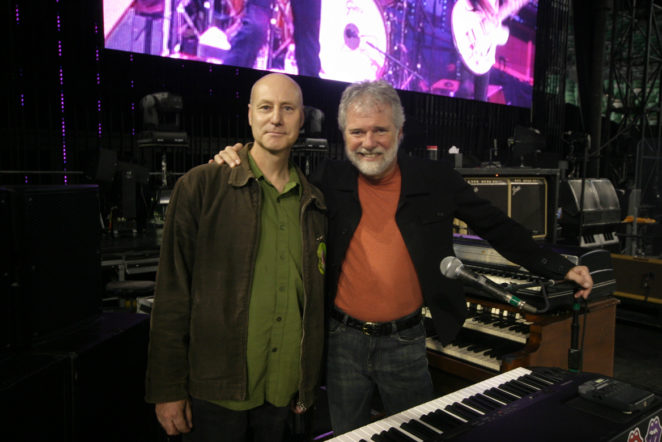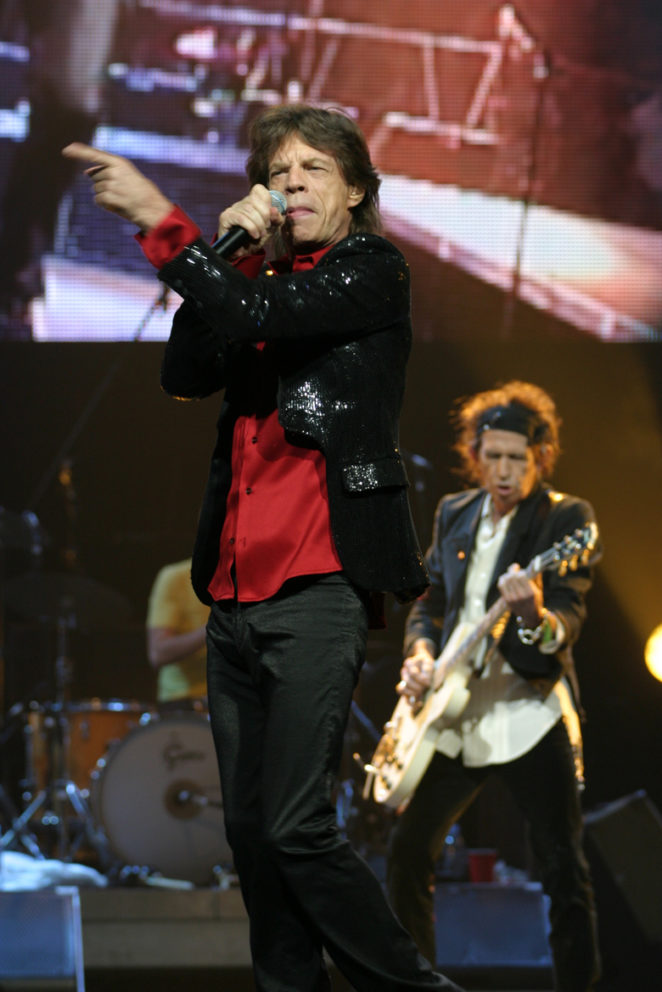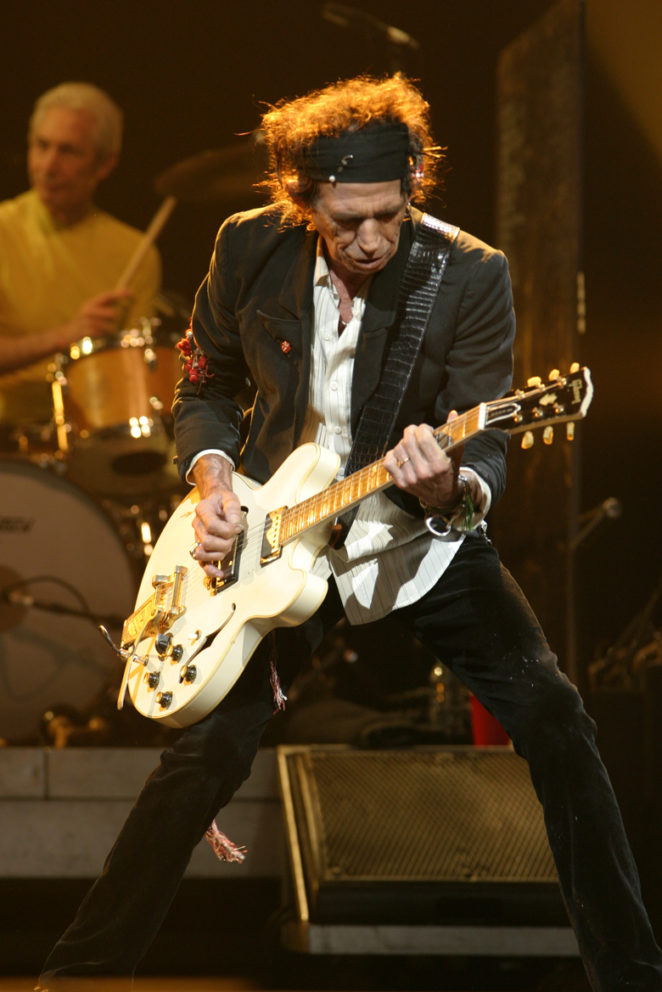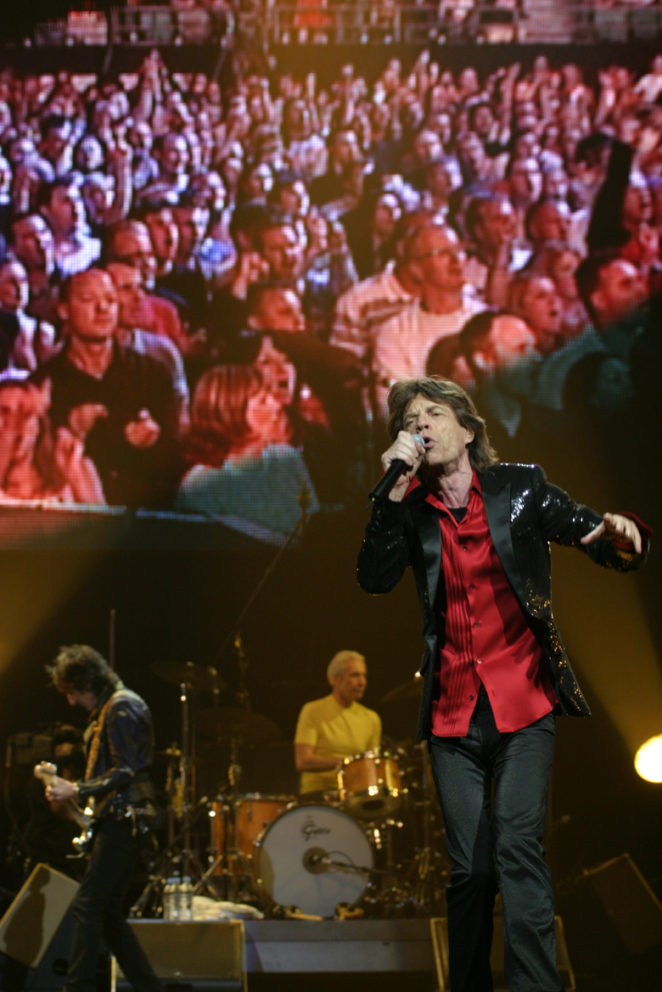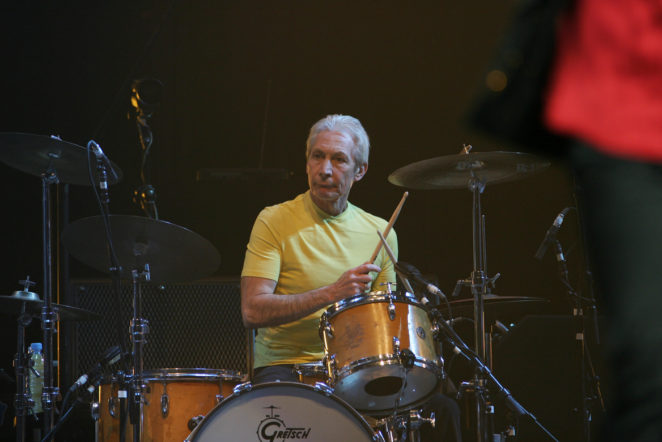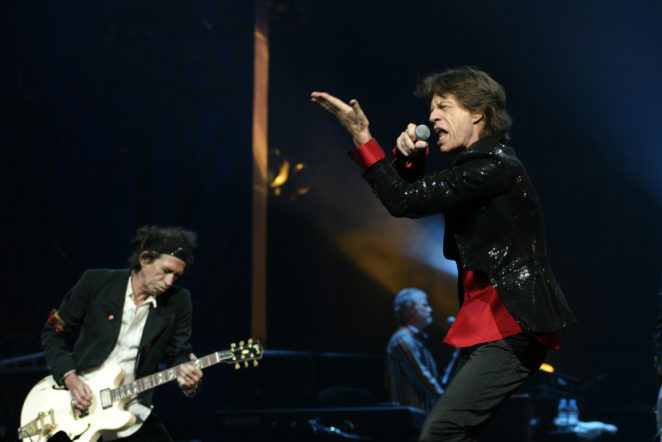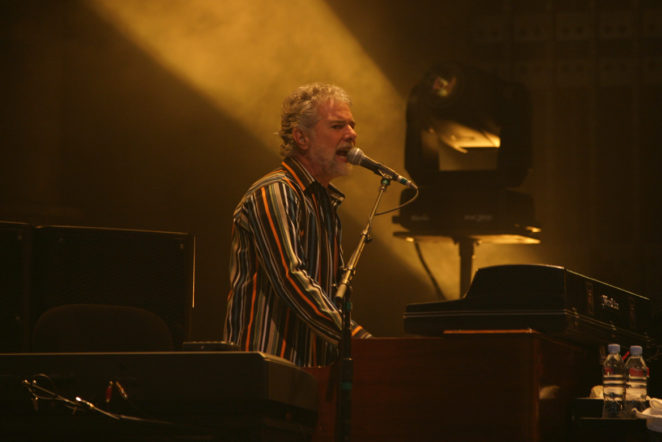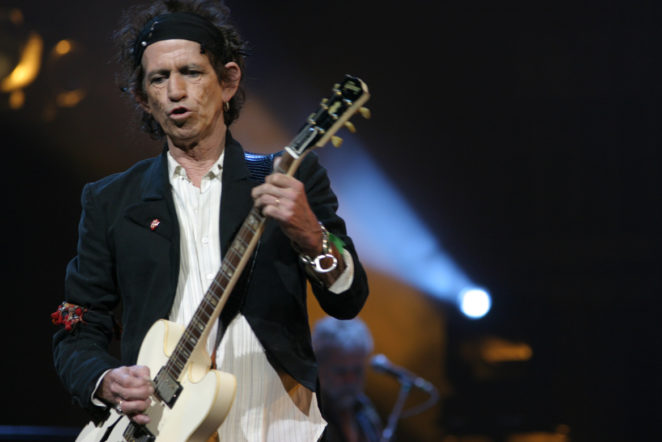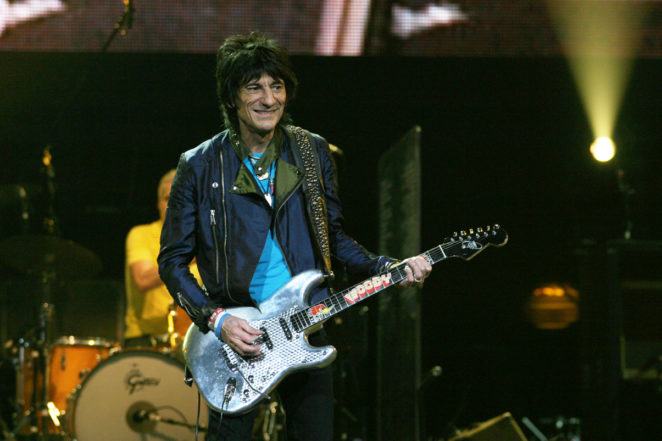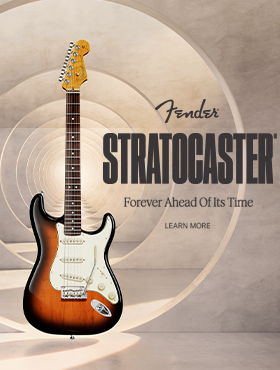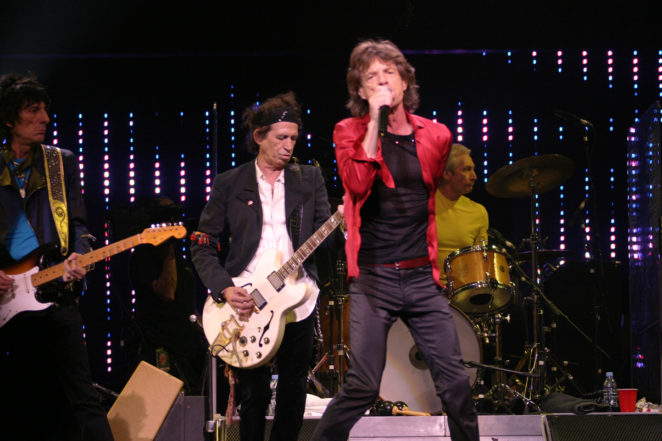
ROLLING WITH THE STONES – Backstage exclusive
August 6, 2006 | Author – Greg Phillips. Photos- Marty Williams
More than forty years on, The Rolling Stones still pack a mighty mean punch on stage. Sure, nostalgia accounts for much of the electricity they generate in their adoring audiences, but so what. Younger bands would kill to have a fraction of the Stones’ legendary back catalogue, Mick and Keith still rock out with the best of them, and to put it simply .. you’ve never seen a real rock show unless you’ve seen The Rolling Stones. Largely responsible for the band’s ongoing ability to impress every night are the two amazing musicians who share their stage … Chuck Leavell on keyboards and Darryl Jones on bass. In this Australian Musician exclusive, Chuck and Darryl kindly share their pre-show afternoon with Greg Phillips at Melbourne’s Rod Laver Arena. All pics by Marty Williams
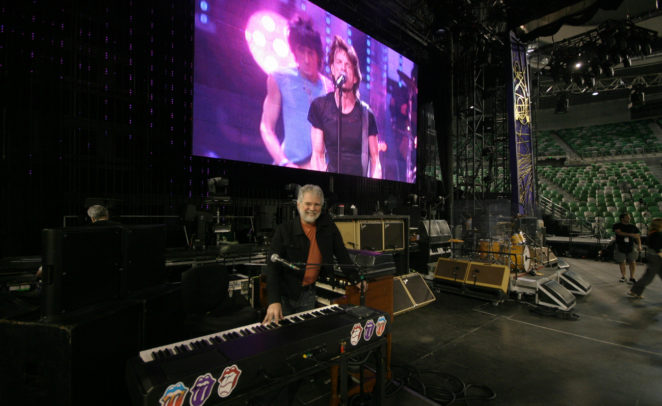
CHUCK LEAVELL-KEYBOARDS
Chuck Leavell is one of the most sought after keyboard players in rock and roll. He first came to prominence with The Allman Brothers Band, most notably stamping his name all over the classic track ‘Jessica’. Since then he has found acclaim in his own band Sea Level, toured extensively with Eric Clapton, appearing on classic recordings such as ‘Unplugged’ and ’24 Nights’, played with George Harrison, Aretha Franklin, The Black Crowes, Train, released two solo albums … and of course has been The Rolling Stones’ piano man for the last two decades. He also happens to be one of the nicest guys in rock music, and when he offered for me to ride along with him to sound check in one of The Stones’ transit vans … how could I possibly refuse?
Two things immediately stood out to me about my backstage Stones experience. Firstly, I knew these guys were rock and roll icons and symbols of contemporary western society, but I wasn’t expecting the level of security that I encountered. “It gets a bit CIA around here sometimes,” said Chuck as Sonic the sniffer dog and three burly minders searched his room for explosives. The other thing that struck me was the almost family-like rapport the 120 member tech crew, made up of every nationality you can imagine, have with each other. Perhaps it was the impending break after two more gigs, or the fact that the Rod Laver Arena gig was in Stones’ terms, an intimate one. Even so, for this many people (220 total touring party) to be assembling then dismantling four 747’s worth of gear every gig day and doing it with a smile on their face, impressed me. As for Chuck Leavell, he always has a smile on his face. He’s just released his second solo album, a tribute to his beloved South called ‘Southscape’, and is equally as proud of his new book ‘The Tree Farmer’. Leavell is a respected conservationist, owning a 2,200 acre tree plantation in Georgia and has co-written a children’s book aimed at educating kids on the importance of tree conservation. But it’s Chuck’s important role with The Stones that I really wanted to dissect.
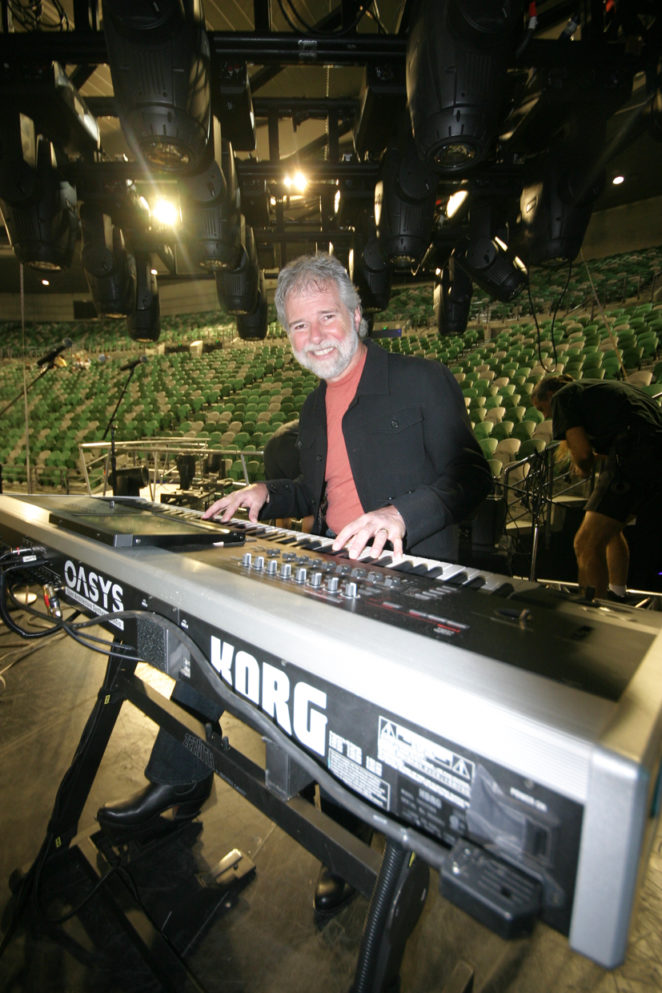 Apart from adding authentic southern blues piano licks to classic Stones songs, Chuck acts as the band’s musical director and is responsible for the nightly set list. He enjoys sifting through the band’s extensive archive and putting forward suggestions for the more obscure songs to add to the live repertoire. I asked him what that process involved.
Apart from adding authentic southern blues piano licks to classic Stones songs, Chuck acts as the band’s musical director and is responsible for the nightly set list. He enjoys sifting through the band’s extensive archive and putting forward suggestions for the more obscure songs to add to the live repertoire. I asked him what that process involved.
“Certainly you reference back to the original recording, ” said Leavell. “Take a song like ‘You Can’t Always Get What You Want’. That is a pretty long piece. To make a little bit of room for other material we took a verse out of it , but still you have the main body of the song, the chorus etc and everybody sings along and it’s still great. That would be a criteria. I have every Rolling Stones song they have ever done on my power book. You just call it up and reference it. If I need to get a quick chart, I’d do that. I keep ongoing records. I have two large volumes of all the rehearsals… even if we do a sound check and we decide to change something. As far as the keys go, most of it is in the original key. When I came into the band… for whatever reason they did ‘It’s Only Rock n’ Roll’ in D instead of E. I guess that had to do with Mick’s vocal.” I put it to Chuck that in my belief, changes to that song detracted from the tune’s original spirit. “I would not disagree with you on that. I love the original recording. You have more acoustic guitar on it, it’s slower, more laid back but this is live. Mick likes the ‘exciting’ thing so we basically turned it into a Chuck Berry song, that’s what it is now. And .. there’s no going back now.. you know…once this band gets a focus on something, there’s no changing it.”
As the afternoon progressed and Ron Wood and Charlie Watts sauntered into the venue, I was just a little bit excited at the thought of witnessing a Rolling Stones sound check. Unfortunately for reasons which never became clear, sound check responsibilities were handed to the crew (who I must say sounded mighty tight). Leavell laments such decisions. He’d not only prefer a sound check for every Stones gig, but a lot more musical preparation before a tour begins. “If I had my way, we’d be rehearsing for six weeks. I think this is the kind of band that needs that kind of space. If it was sensible and affordable to do so, you would definitely see a larger repertoire with this band. A Stones’ rehearsal is a really interesting thing. It doesn’t really go very fast. You get there and everybody has a drink or two and talks about their life and family or whatever. Eventually someone slaps on a guitar and starts playing .. something. We join in and we warm up. Then there’s a break! We go and eat and come back. Very rarely is it regimented and you really get down to business. Sometimes it drives me nuts because I’m a musician man and I want to get to the point.”
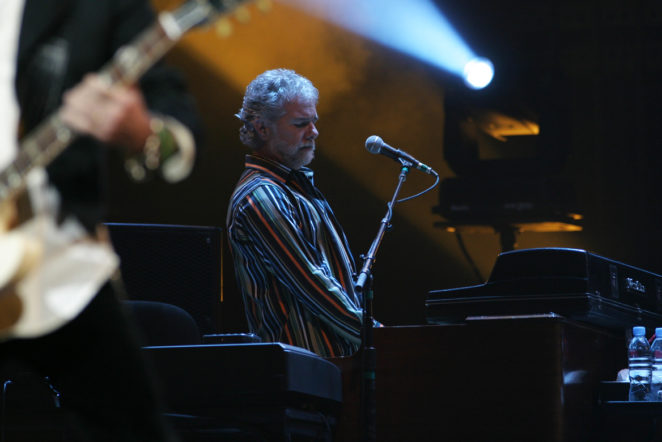
On stage Chuck uses an impressive array of keyboards including a beautiful old Wurlitzer model 200 electric piano which he picked up in Japan, and his trusty MIDI Hammond B organ which was modified during the Steel Wheels tour by Florida Hammond tech Paul Homb. “He does what he calls a super stock treatment to Hammonds when he refurbishes them. He is very particular about using the correct vacuum tubes and so forth but with more dependability and reliability, but he likes to keep it as stock as possible.” said Chuck of the modifications. “I also use a CX3 when we do the B Stage. Obviously the Hammond is a bear to haul out so the CX3 is perfect for that. We put it on top of an M Audio controller and then we’re triggering a Yamaha Motif under the B stage for the piano sounds and then we’re also using an M Audio for the Wurlitzer sound.”
In addition to the vintage gear The Rolling Stones also use the latest cutting edge technology from Korg including the new Oasys synthesiser. “The best application for the Oasys now with this band is that it is so accurate with the orchestral sounds. During ‘Angie’, when Tim Ries comes down to play the string parts, and also on ‘Paint it Black’, and ‘Memory Motel’. Tim plays the Oasys. We also use the Oasys when we play ‘Worried About You’. Mick plays the keyboard on that and we put the Oasys front and centre stage. He sits down on that and gets the Fender Rhodes sound on it.” Leavell has also MIDI’d the Oasys for some piano sounds and looks forward to further exploring the unit’s capabilities when he re-outfits his home studio when the Bigger Bang tour winds up at the end of the year. His other on stage Korg keyboard is the Triton, which he has used for many years. “I’ve been associated with Korg for a long time. I think they make really great gear.” Chuck also plays a Yamaha P200 for his basic piano sounds.
Leavell is a blues player through and through and is aware that once The Stones are gone, there aren’t too many others left carrying the blues torch. “A lot of our heroes are already gone and the ones that are here are getting on in years, but thank god they’re still out there working and that provides inspiration to us. And I hope it makes sense for this band to go forward. That’s the inevitable question with this band. Is this the last tour? How much longer can you go on? When you look at BB King and even the jazz guys, they worked up to their dying days so… I don’t know if that will be the case with these guys. I doubt it, but it does provide inspiration to go forward and that’s a good thing.” said Chuck with perhaps a hint that an end to The Rolling Stones touring days might finally be in sight.
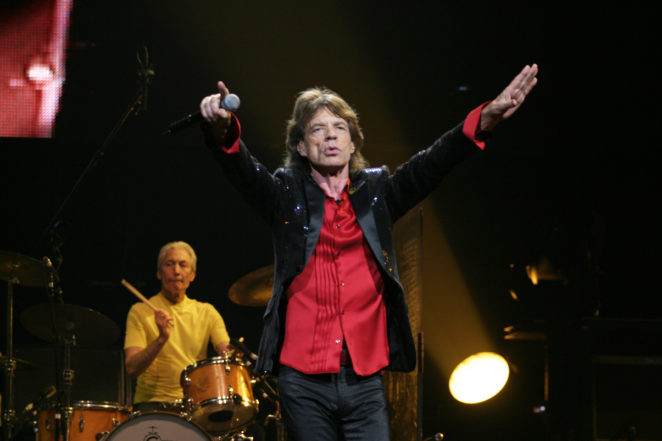
With our interview completed, Chuck suggested we grab a bite to eat in the dining room, an area which after 6.30pm transforms into The Rattlesnake Inn, the band’s meet and greet area for family and invited guests. I enquired as to the chosen set list for the night and Chuck revealed that ‘Jumpin’ Jack Flash’ would be the opener. My suggestion that it went down well last time The Stones opened with that song in Melbourne resulted in Leavell suddenly wiping his mouth, pushing his plate aside and setting off to find Mick Jagger. Apparently they never do the same thing, the same way in the same city twice. Left to my own devices I continued to enjoy the Rolling Stones’ hospitality as guests and band members began to roll into The Rattlesnake including a film director, a Golden Globe winner, the concert promoter’s family, and Keith Richards’ daughter Theodora and Australian partner. Keith, Woody and Mick however, preferred the privacy of the pool room on the night. I hadn’t even seen the gig yet, and the day had already been an incredible experience. I’d witnessed the Stones backstage activity, stood on their stage, ate their prawns, drank their beer and innocently had a hand in changing the order of the set list. How apt that they opened with ‘Satisfaction’.
For more information on Chuck including his new album ‘Southscape’, visit his website: www.chuckleavell.com
 DARRYL JONES-BASS
DARRYL JONES-BASS
The groggy voice on the other end of the telephone line indicated that I’d probably called Rolling Stones bassist Darryl Jones a little too early. I think he said ‘I’ll call you later”. However, as I hurriedly placed the receiver back down, it occurred to me I may have misinterpreted “I’ll kill you later!” It was with some relief that the friendly face greeting me backstage in the band’s dining area later in the day was a well rested and cheerful Darryl Jones.
Chicago born bassist Darryl Jones came to the Rolling Stones in 1994 armed with major credentials. His first professional job was playing bass for jazz great Miles Davis, a career highlight for anyone let alone your debut gig. However, the ever musically adventurous Jones was just starting out, and went on to explore the pop and rock genres landing gigs with artists as significant as Sting, Clapton, Madonna, and both Springsteen and Peter Gabriel on the Amnesty International tour. Jones auditioned for The Stones after original bottom ender Bill Wyman decided to finally cash in his retirement plan, daunted by the thought of the massive and fast approaching Voodoo Lounge world tour. Jones had never seen the Stones perform, but was known to band and had occasionally crossed touring paths with Keith. Charlie Watts was particularly pleased at the thought of having a jazz alumnus trading licks beside him on stage. While traditionalists pined for Stones authenticity, many others believed Jones was the shot of adrenaline the band was drastically in need of. The job brief conveyed to Jones was simple: do what he does best and provide a solid bottom end. Keith Richards was more specific; he suggested that Darryl not worry too much about replicating Wyman’s work. Bill’s influences were old school Motown, jazz and blues. Jones’ tastes were similar, but more by osmosis, tasting those flavours via second generation bands like The Stones, and other jazz and blues influenced artists of the sixties and seventies. There was also a more contemporary rock and funk string to Jones’ bow. Physical attributes alone would dictate that Jones was never going to clone Bill’s playing style anyway. The tall Afro-American Jones is an imposing figure, whereas the more diminutive Wyman admits he could never even hold the style of bass that Jones prefers. ‘I’m quite slightly built and my hands are very small for a man,’ Wyman told Australian Musician back in 1997. ‘I can’t play a double bass. I can’t play a Fender bass, they’re all too big. I’ve always played those small narrow necked guitars.’
Jones’ is now firmly entrenched as The Stones’ permanent bass player and is an integral part of the band’s sound. As a member of rock n roll’s version of a PT Barnum extravaganza, Darryl enjoys similar luxuries to the four main protagonists, and is grateful for the experience. But deep down he knew that playing the big stages was always going to be his destiny. A recent meeting with an old musician friend from Chicago, Jorge Evans, reminded Jones of his aspirations as a twenty year old.
‘We were on a gig together back in Chicago.’ recalls Jones. ‘Afterward, I was on the curb with my gear waiting for a cab. He (Evans) was loading his gear into his car and he asked me what I was doing. I said I was waiting for a cab. He said,”You’re gonna spend everything you made tonight to get home?” I replied, “Yeah, well!” Jorge is a very good man and he flat out refused to leave me on that curb. He said we’d find a way to fit both our rigs in his car and it was a tight fit but we did it.
“About six months ago I was with him in LA and he reminded me of this night. He asked me if I remembered what I’d said to him that night on the way home. That night he’d asked me, Darryl, why would you do a gig then spend all of the money you got paid to get home afterward. He said my response was, “Jorge, it won’t always be like this.” I guess I was so full of hope and dreams that I always believed things would change.’
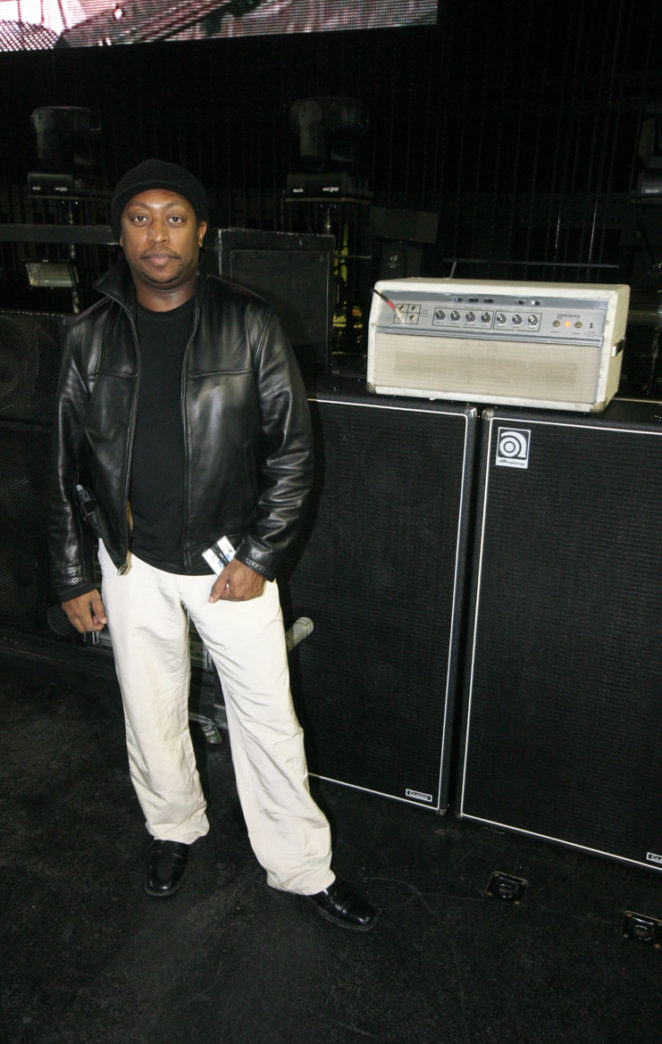 It would be easy to assume that while on stage, Jones keenly tunes into every motion of Charlie’s drum sticks, but surprisingly, it’s Mick Jagger rather than Mr Watts who attracts more of Darryl’s eyeline on a nightly basis. ‘As a bassist, part of what I do automatically is to listen to the drummer. I don’t have to think of that anymore. It’s the natural thing for me to do. I would say that if there’s anyone I find myself exerting energy to listen to it would be Mick. That might sound funny but I watch him more carefully than anyone else onstage because he’s the frontman. There are certain physical cues I get from him that tell me where he’s going or what he’ll do,’ Jones explains.
It would be easy to assume that while on stage, Jones keenly tunes into every motion of Charlie’s drum sticks, but surprisingly, it’s Mick Jagger rather than Mr Watts who attracts more of Darryl’s eyeline on a nightly basis. ‘As a bassist, part of what I do automatically is to listen to the drummer. I don’t have to think of that anymore. It’s the natural thing for me to do. I would say that if there’s anyone I find myself exerting energy to listen to it would be Mick. That might sound funny but I watch him more carefully than anyone else onstage because he’s the frontman. There are certain physical cues I get from him that tell me where he’s going or what he’ll do,’ Jones explains.
Currently, Jones’ weapon of choice is a Fender Mustang which he picked up recently in Japan. The Mustang was the first bass Darryl ever played, leading to him becoming the Fender-style bass fan he is today. When he co-designed the A bass with Albey Balgochian, which Lakland now produce as the Darryl Jones Signature J-style bass, he found it difficult to divert from the Jazz style that Fender had already perfected. ‘We springboarded off of a Fender Jazz bass.’ Jones freely admits. ‘Leo Fender got it so right that we felt it was the best place to start. We wanted an extra fret up high so we had to change the cutaway (you have no idea how hard it is to divert from the Fender shape and not come up with something very odd looking) and a few more attributes of the PreCBS model. Also, the DJ bass has a slimmer body.’
The Mustang and the Darryl Jones model Lakland are just two of several which lay off stage in a rack awaiting a quick switch, depending on the make up of the night’s set list. ‘This tour I’ve tried to tailor the instruments I play more specifically to the songs,’ he offers. ‘I’m using chambered instruments on this tour much more than before. The F.B. bass by Fritz Brothers guitars and the Gretsch Electrotone G6073. These are great for things like Paint It Black,The Back Of My Hand and Ruby Tuesday and Angie respectively.’ As for strings, Darryl uses stainless steel round wound 45 – 105 on the J-style basses, flat wounds on the P basses, and half-rounds on a couple of others.
More than anything, sound and tone are Darryl’s main concern, and to achieve his needs he places great emphasis on pure power. ‘I think you need a lot more than 300 watts to produce a clear, heavy, punchy bass sound,’ he said. ‘I’ve never had anyone complain about me being too loud. I’ve had people say, “Man, I could feel the bass in my chest” or “Your sound is so clear and distinct.” It’s just my philosophy.’
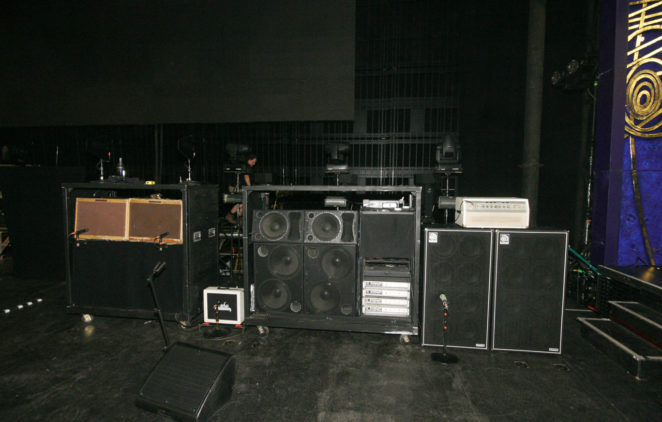
While Jones was playing with Miles Davis he was comfortable using an Ampeg SVT with Hartke replacement speakers to emit his sound. It wasn’t until he was playing with Sting and heard his bass coming through Omar Hakim’s drum monitor that he became a convert to the Meyer PA sound, and has been using configurations of their gear ever since. However, on this current tour Jones has added a couple of Ampeg SVT amps for a warmer tube sound. ‘Because the Meyer rig is a tri-amp system, it’s impossible to mike in this situation. Tube amps respond differently to the touch than solid state amps, much more sensitive, so I’m experimenting with that difference now.’
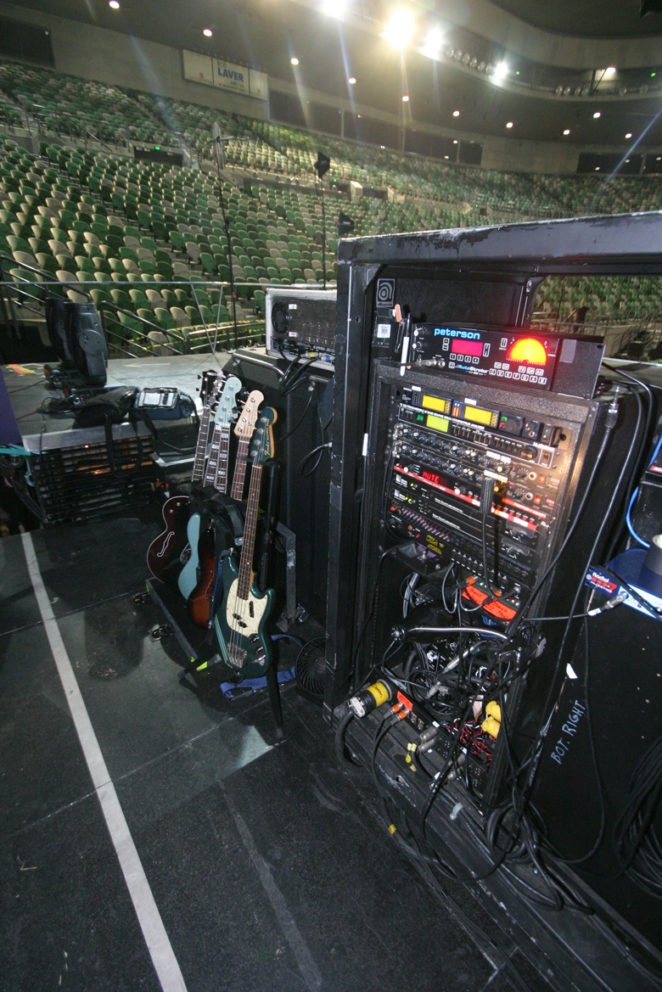 Ken Fallon has been working with The Stones’ guitars on and off since the Steel Wheels tour of 1989. Last year, Stones’ crew chief Pierre DeBeauport asked Ken to come down and “fix some guitars for a few days”. At the time Jones was without a tech. Ken started looking after Darryl’s instruments during the rehearsals and from that moment on, was hired as Jones’ official bass tech. Nobody knows more about Darryl’s rig than Ken, particularly his signal chain. “Darryl runs a 2 channel Shure wireless to Rocktron Patchmate switcher to a Radial JD7 Injector, which splits the signal to an early 70’s Ampeg SVT head through a pair of Ampeg SVT 810 Classic cabinets, and also to a pair of Ashly BP41 preamps (one for J bass, one for P bass) to the Meyer crossovers, to 3 Crown amps then to the pair of Meyer tri-amped speaker cabinets. Each of the two Meyer speakers consist of 2×15, 1×12, and a horn.
Ken Fallon has been working with The Stones’ guitars on and off since the Steel Wheels tour of 1989. Last year, Stones’ crew chief Pierre DeBeauport asked Ken to come down and “fix some guitars for a few days”. At the time Jones was without a tech. Ken started looking after Darryl’s instruments during the rehearsals and from that moment on, was hired as Jones’ official bass tech. Nobody knows more about Darryl’s rig than Ken, particularly his signal chain. “Darryl runs a 2 channel Shure wireless to Rocktron Patchmate switcher to a Radial JD7 Injector, which splits the signal to an early 70’s Ampeg SVT head through a pair of Ampeg SVT 810 Classic cabinets, and also to a pair of Ashly BP41 preamps (one for J bass, one for P bass) to the Meyer crossovers, to 3 Crown amps then to the pair of Meyer tri-amped speaker cabinets. Each of the two Meyer speakers consist of 2×15, 1×12, and a horn.
There are various effects and additional EQ available as well ( distortion, envelope follower, etc. ) which are inserted through the Rocktron Patchmate.” explains Fallon. “The B-Stage rig is another 2 channel Shure wireless receiver to a Lehle Dual A/B box to a Countryman DI , on to another old Ampeg SVT head and one SVT 810 Classic cab.”
 The Bigger Bang tour, which commenced in August 2005, winds up at the end of this year. While solo musical projects and acting work beckon (he’s already appeared in three movies), for the time being Jones is more than content to saddle up alongside Charlie Watts thumping out bass lines to classic Stones’ songs. Unless, of course, if those rumours that Charlie is bailing out after this tour prove true.
The Bigger Bang tour, which commenced in August 2005, winds up at the end of this year. While solo musical projects and acting work beckon (he’s already appeared in three movies), for the time being Jones is more than content to saddle up alongside Charlie Watts thumping out bass lines to classic Stones’ songs. Unless, of course, if those rumours that Charlie is bailing out after this tour prove true.
For more information on Darryl, visit www.darryljones.com
